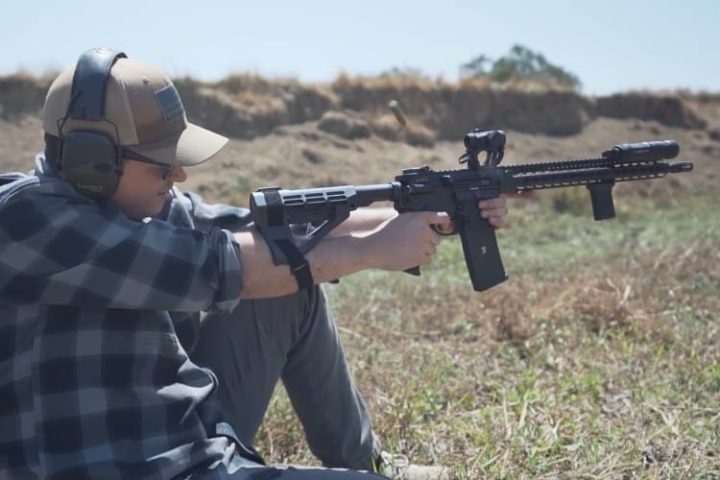
Back in 2012, the ATF (the Bureau of Alcohol, Tobacco, Firearms and Explosives) ruled that pistol stabilizing braces didn’t turn pistols into short-barreled rifles, and therefore they were exempt from inclusion under the 1934 National Firearms Act (NFA). The NFA is a national registry of certain firearms and accessories such as machine guns, suppressors, short-barreled rifles (barrel less than 16″) and short-barreled shotguns (barrel less than 18″). Possessing an NFA item without jumping through the proper hoops, including registration and the payment of a $200 fee for a “tax stamp,” is a felony subjecting one to 10 years in prison and a $250,000 fine. Many see the NFA as a precursor to a national registry of all privately owned firearms.
On Friday, Attorney General Merrick Garland signed a “final rule” stating that any firearm that uses a pistol brace will be “considered a ‘rifle’ or ‘firearm’ subject to regulation under the NFA.”
Garland rolled out the canard that the agency’s primary concern is public safety:
Keeping our communities safe from gun violence is among the Department’s highest priorities.
Almost a century ago, Congress determined that short-barreled rifles must be subject to heightened requirements. Today’s rule makes clear that firearm manufacturers, dealers, and individuals cannot evade these important public safety protections simply by adding accessories to pistols that transform them into short-barreled rifles.
To clarify: The ATF has little interest in keeping communities safe when it moves to disarm law-abiding citizens, or impose such onerous regulations that they effect the same end. Instead, it has from the beginning been a tool to enact gun control.
The National Firearms Act was passed in 1934 following Al Capone’s reign of terror in Chicago. While citizens were out of work and struggling just to keep food on the table during the Great Depression, the Roosevelt administration saw its chance to infringe on the Second Amendment. It passed muster with the Supreme Court, and has been a thorn in the side of law-abiding gun owners ever since.
A pistol-stabilizing brace is simply a device that, while similar in appearance to a rifle buttstock, is designed to be strapped on to the shooting arm of the user, allowing disabled people to more comfortably fire a rifle-style gun with one arm. Of course, it can also be used to shoulder-fire the weapon as a rifle. Since the ATF’s 2012 ruling that this device does not turn a firearm with a stabilizing brace and a barrel less than 16″ into a short-barreled rifle subject to the NFA, sales have skyrocketed. Estimates are that some 40 million such braces exist in the country.
That 2012 ruling has now been overturned.
ATF Director Steven Dettelbach, a hard-core anti-gun operative who previously served under Barack Obama as U.S. attorney for the Northern District of Ohio, rejoiced in the rule change:
This rule enhances public safety and prevents people from circumventing the laws Congress passed almost a century ago.
Certain so-called stabilizing braces are designed to just attach to pistols, essentially converting them into short-barreled rifles to be fired from the shoulder.
Therefore, they must be treated in the same way under the [NFA] statute.
When the rule change was first proposed there was pushback — major pushback. There were nearly a quarter of a million negative public comments made on the ATF website. There is a bill called “Stop Harassing Owners of Rifles Today Act (SHORT Act) introduced by Senator Roger Marshall (R-Kan.) that would remove short-barreled rifles, short-barreled shotguns, and certain other weapons from the NFA.
Said Marshall, “My bill is the only way to ensure the Constitutional rights of gun owners are protected against the ATF’s reckless abuse of the NFA to justify its pistol brace rule.”
Marshall’s bill, of course, won’t see the light of day in the anti-gun, Democrat-controlled Senate.
There was also a letter from the Senate Republican Caucus to AG Garland demanding that he withdraw the rule:
The way the proposed rule is written makes clear that ATF intends to bring the most common uses of the most widely possessed stabilizing braces within the purview of the NFA. Doing so would turn millions of law-abiding Americans into criminals overnight, and would constitute the largest executive branch-imposed gun registration and confiscation scheme in American history.
Of course. That is the whole point. Garland, Dettelbach, and the agency ignored all of this pushback and moved ahead with their grievous infringement of the Second Amendment anyway.
Some can take heart over the decision last week by the U.S. Fifth Circuit Court of Appeals, Cargill v. Garland. An initial lawsuit against another ATF proposed rule change had been tossed at the district level. On appeal, a panel at the Fifth Circuit agreed. But an en banc rehearing at the First Circuit ruled against the lower court and the panel, stating,
a plain reading of the statutory language, paired with close consideration of the mechanics of a semi-automatic firearm, reveals that a bump stock is excluded from the technical definition of ‘machinegun’ set forth in the Gun Control Act and National Firearms Act.
A bump stock is not a pistol brace, but the breach by the infringement by the ATF is the same. From the Cargill ruling:
A bump stock is a firearm attachment that allows a shooter to harness the natural recoil of a semi-automatic weapon to quickly re-engage the trigger after firing, enabling him to shoot at an increased rate of speed.
When ATF first considered the type of bump stocks at issue here, it understood that they were not machineguns. ATF maintained this position for over a decade, issuing many interpretation letters to that effect to members of the public.
But ATF reversed its longstanding position in 2018, subjecting anyone who possessed a bump stock to criminal liability.
Michael Cargill gave up his bump stocks to the ATF and then sued the agency:
Appellant Michael Cargill surrendered several bump stocks to the Government following publication of the regulation at issue.
He now challenges the legality of that regulation, arguing that a bump stock does not fall within the definition of “machinegun” as set forth in federal law, and thus that ATF lacked the authority to issue a regulation purporting to define the term as such.
Cargill is correct. A plain reading of the statutory language, paired with close consideration of the mechanics of a semi-automatic firearm, reveals that a bump stock is excluded from the technical definition of “machinegun” set forth in the Gun Control Act and National Firearms Act….
The Final Rule promulgated by the ATF violates the APA [the federal statute that governs how federal agencies propose and establish rules such as this]. We therefore REVERSE the judgment of the district court and REMAND [return] with instructions to enter judgment for Cargill.
Pro-Second Amendment groups are busy crafting a similar lawsuit, hoping that the precedent set by the Fifth Circuit (which encompasses Louisiana, Mississippi, and Texas) will extend to pistol braces as well.



